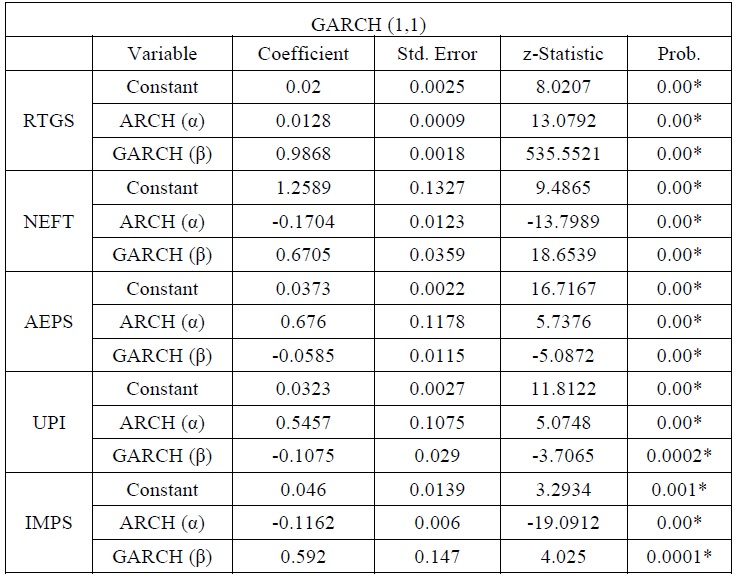The E-Payment Trajectory during the Pandemic – The Case of India
DOI:
https://doi.org/10.54741/mjar.3.1.4Keywords:
e-payment, pandemic, garch, indiaAbstract
This study empirically investigates how the different e-payment methods performed during the pandemic as an alternative medium to the traditional mode of payment. E-payment methods namely Real Time Gross Settlement (RTGS), National Electronic Fund Transfer (NEFT), Aadhaar Enabled Payment System (AEPS), Unified Payments Interface (UPI), and Immediate Payment Service (IMPS) are considered from June 1, 2020, to November 30, 2021, when the global pandemic was at its peak. Secondary daily data are considered in this study collected from the RBI database which was converted into corresponding log natural returns. GARCH (1,1) model was applied as the tool for analysis. It was noted that RTGS, AEPS, and UPI undergo positive volatility whereas NEFT and IMPS undergo negative volatility which enables us to conclude that RTGS, AEPS, and UPI are much more acceptable mediums of payments during the pandemic than the others.
Downloads
References
Acopiado, M. A., Sarmiento, J. M. P., Romo, G, D. A. Acuna, T. R., Traje, Adonis M. W., & Geraliza, D. (2022). Digital payment adoption during the COVID-19 pandemic in the Philippines, Phillipines Journal of Science, 151(3), 1185-1196.
Chugh, S., Vibhu, G., Kanojia, S., Kumar, V., & Pal, S. K. (2020). To study the impact of advancement in e-payment technology used in India. PalArch's Journal of Archaeology of Egypt/Egyptology, 17(6), 1617-1635.
Isa, S. M., Wei, I. M. C., & Santoso, S. (2021). Adoption of e-wallet among penang residents during the covid-19 pandemic: The moderating roles of rewards. 1(14), 1.
Lakhwani, R. (2022). Effect of covid-19 pandemic on digital payment ecosystem. International Journal of Engineering Research and Technology (IJERT), 11(3), 358-362.
Panwar, M., Chowdhury, R., & Vashishtha, A. (2020). Impact of covid-19 pandemic on digital payment. World of innovative research (WIJR), 9(4), 77-81.
Sagarik, D. (2021). Rethinking and reshaping Thailand’s national e-payment in the post-covid era. International Journal of e-Business and e-Government Studies, 13(1), 240-262.
Saroy, R., Awasthy, S., Singh, N. K., Admi, S. M., & Dhal, S. (2021). The impact of covid-19 on digital payment habits of indian households. Bulletin of Monetary Economics and Banking, 25(15), 19-42. https://doi.org/10.21098/bemp.v25i0.1823.
Srouji, J., & Torre, D. (2022). The global pandemic, laboratory of the cashless economy?. International Journal of Financial Studies, 10(109), 1-13.
Toh, Y., & Tran, T. (2020). How the COVID 19 Pandemic May Reshape the Digital Payments Landscape, Payments System Research Briefing, Federal Reserve Bank of Kansas City, pp. 1-10.
Vinitha, K., & Vasantha, S. (2017). Factors influencing consumer’s intention to adopt digital payment - conceptual model. Indian Journal of Public Health Research and Development, 8(3), 170–175. https://doi.org/10.5958/0976-5506.2017.00181.4.
Zokaee, S., & Ghazizadeh, M. (2012). Electronic payment systems evaluation: a case study in Iran. Information Management and Business Review, 4(3), 120-127.

Downloads
Published
How to Cite
Issue
Section
License
Copyright (c) 2023 Subhajit Bhadra, Saba Naaz, Dr. Raktim Ghosh

This work is licensed under a Creative Commons Attribution 4.0 International License.
Research Articles in 'Management Journal for Advanced Research' are Open Access articles published under the Creative Commons CC BY License Creative Commons Attribution 4.0 International License http://creativecommons.org/licenses/by/4.0/. This license allows you to share – copy and redistribute the material in any medium or format. Adapt – remix, transform, and build upon the material for any purpose, even commercially.









